Forces and Elasticity (GCSE Physics)
Forces and Elasticity
Forces Acting On Objects
Forces can cause stretching, bending or compression of an object. You need to understand each of these three effects, and give examples of forces causing each.
Stretching, bending and compression require multiple forces to be acting on an object. For example, if you just pushed a spring, then it would move in a certain direction. But if you pushed both ends of the spring, the spring would compress.
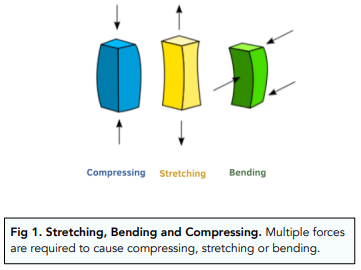
Stretching an Object
- Stretching is caused by pulling forces. To stretch a spring, we have to pull on it. This can be done by adding some small weights to the end of the spring, making it change in length.
- Pulling causes a spring to stretch. As the weights are added onto the spring, the length of the spring will increase. The spring has stretched from its original length to a new, longer length. This is called extension.
Compressing an Object
- Compression is caused by pushing forces. To compress a spring, we have to push it. This can be done by pushing the two ends of the spring together, making it change in length.
- Pushing causes a spring to squash. As the two ends are pushed together, the length of the spring will decrease. The spring has been compressed from its original length to a new, shorter length. This is called compression.
Bending an Object
- Bending forces can be push or pull. A force that causes a bend can either be a push force (Fig 2) or a pull force (Fig 3).
- The centre of an object will bend the most. When a force causes an object to bend, the centre of the object will be the ‘bendiest’ part. This causes the ends of the object to move closer towards each other. This is shown in Fig 16; the centre of the object is bending, whilst two ends move towards each other (in this case, they are moving upwards).
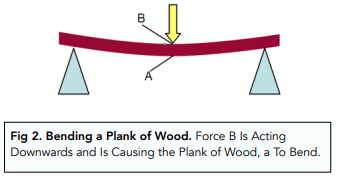
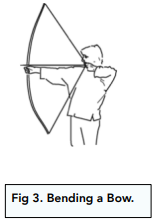
Changing the Shape of Stationary Objects
Applying One vs., Multiple Forces
For exams, we need to learn the effects of different forces on stationary objects. We discuss above that stretching, bending and compressing require multiple forces.
- Applying a single force causes movement. When a single force is applied to a stationary object, the object will move in the direction of the force. There is no change of shape, since only one force has been applied.
- Applying multiple forces causes change of shape. When multiple (two or more) forces are applied to a stationary object, r
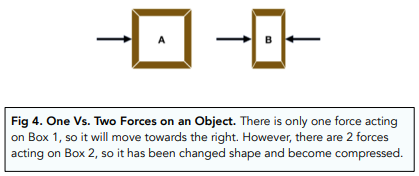
Elastic and Inelastic Deformation
- Deformation is a change in shape. An object is said to be deformed when it has changed shape and length, due to the effect of forces. There are two types of deformation: elastic and inelastic.
- Elastic deformation is reversible. If an object completely returns to ‘normal’ once all forces are removed, it is said to be elastically deformed. By normal, we mean that the object has completely returned to its original shape, size and length.
- Inelastic deformation is irreversible. if an object doesn’t completely return to ‘normal’ once all forces are removed, it is said to be in elastically deformed. Another term used to describe inelastic deformation is plastic deformation.
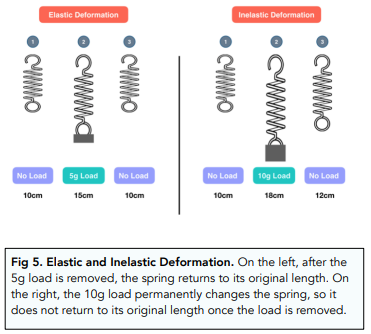
The Relationship between Force and Extension
Hooke’s Law
Hooke’s law is used to describe the relationship between force applied to an elastic object and the extension of the elastic object. It is a linear relationship, where force is directly proportional to the extension. If an object doesn’t obey Hooke’s law, there is a non-linear relationship between force and extension.


Where:
- Force, F, in newtons (N)
- spring constant, k, in newtons per metre (N/m)
- extension, e, in metres (m)
Extension is the difference between the original length and the new, longer length.
We will learn about the spring constant below.
The Spring Constant
Linear Cases
The spring constant is used to describe the ‘stiffness’ of a spring. If the spring constant is very high, it means that the spring is very stiff.

For exams, we need to calculate the spring constant in linear cases.
The spring constant can be found by rearranging Hooke’s Law.
Hooke’s Law:

We want to find k, so we can rearrange the equation to give:

Calculating The Spring Constant
Question: A force of 10N is applied to a spring that is 50cm long. The spring extends to a value of 70cm. Calculate the spring constant, with units.
1. Write down the equation for Hooke’s Law.
F = k e
2. Find the extension.
The units of extension are in metres, so we will have to convert from cm to m in this example.
20cm = 0.2m and 70cm = 0.7m
The extension is 0.7 – 0.2 = 0.5m
3. Rearrange the formula.
F / e = k
4. Substitute for numbers.
Using the information given in the question, put in the value for force. The value for extension is the number we have just calculated.
5. Give the correct units.
In this question, we are asked to find the spring constant with its units.
Spring Constant = 20 N/m
Relationship Between Force and Extension
Direct Proportionality
- Extension occurs due to force. When we apply force to an elastic object (such as a spring) it will extend. The extension of an elastic object can be described by Hooke’s law.
- Force and extension are directly proportional. When we increase the force, the extension will also increase by the same amount. This is called direct proportionality, which is often obeyed by elastic objects such as springs.
- Direct proportionality forms a straight line graph. As a graph is plotted of force (on the y axis) against extension (on the x axis), a straight line will start to form. This straight line will go through the origin, since when there is no force applied, there will be no extension.

Limit of Proportionality
The limit of proportionality is when the spring stops obeying Hooke’s Law. It is the point where the force applied to the spring is too large for the spring to handle. As a result, the extension of the spring increases drastically, and the two variables are no longer in a proportional relationship.
We learnt before about elastic and non-elastic deformation. After the limit of proportionality, the spring has non elastic deformation, and will not return to its original length once the load is removed.

For exams, there are several important things to remember about the limit of proportionality:


You need to be able to describe the difference between a linear and non-linear relationship between force and extension:
- Linear relationships obey Hooke’s Law. Previously, we mentioned that there is a linear relationship between the force and extension of elastic objects. This linear relationship can be described by Hooke’s Law.
- Non linear relationships do not obey Hooke’s Law. Past the limit of proportionality, elastic objects will not obey Hooke’s law. This means that there is no longer a non-linear relationship between force and extension.
The Relationship Between Force and Compression
Compression vs. Extension
- Compression and extension are opposites. We know that extending a spring means increasing its length, so compressing a spring will decrease its length. The amount of force applied will be the same in both scenarios, but the direction of the force will be different (Fig 9).
- Extension is the difference between the original length and the new, longer length.
- Compression is the difference between the original length and the new, shorter length.

Compressing Elastic Objects
Similar to extension, we can use Hooke’s law to describe the compression of an elastic object. This means that there is a directly proportional relationship between the force on an object and the compression it experiences.
The equation linking force and compression is:

Where:
- Force, F, in newtons (N)
- spring constant, k, in newtons per metre (N/m)
- compression, c, in metres (m)
Forces are pushes or pulls that can change an object’s motion or shape. Forces can be caused by many things, including friction, gravity, and magnetic attraction.
Elasticity is the property of an object that allows it to return to its original shape after it has been deformed by an applied force. Elasticity is related to the elastic limit, which is the maximum amount of force that can be applied to an object before it permanently deforms.
Elastic potential energy is the energy stored in an object when it is stretched or compressed. This energy is stored as a result of the elastic forces within the object, and it can be calculated by multiplying the force applied to the object by the distance it is stretched or compressed.
Hooke’s Law is a scientific principle that states that the extension of a spring is directly proportional to the force applied to it, as long as the spring remains within its elastic limit. This law is named after Robert Hooke, who first described it in the 17th century.
The elastic limit is the maximum amount of force that can be applied to an object before it permanently deforms. When an object is subjected to forces beyond its elastic limit, it will not return to its original shape after the force is removed.
Elasticity and forces are closely related because forces can cause objects to change shape, and the ability of an object to return to its original shape after being deformed by a force is related to its elasticity. When a force is applied to an object, it will deform and store elastic potential energy, and when the force is removed, the object will return to its original shape as the stored energy is released.
The study of forces and elasticity is important in GCSE Physics because it is a fundamental concept that is required to understand many other aspects of physics, such as mechanics and waves. Understanding how forces affect the motion and shape of objects, and how elasticity can be used to describe and predict the behavior of objects under stress, is essential for success in GCSE Physics.





Still got a question? Leave a comment
Leave a comment